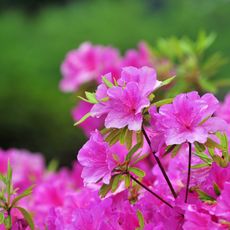Top 10 Questions About Jasmine Plants

If you're at all like me, you don't just choose plants that are sensible, you pick those that delight your senses. Jasmine fits the bill with its romantic flowers and honey sweet fragrance. You can find jasmines that are perfect for the summer garden or evergreen varieties that light up your backyard in winter.
Even though jasmine is relatively simple to grow, questions do arise, and here at Gardening Know How, our goal is to provide solid answers to those inquiries. The following information includes the 10 most commonly asked questions about jasmine plants.
1) When do you plant jasmine outdoors?
Many of us buy jasmine as container plants, enjoy them indoors for a time, then move them out into the garden. This system works well as long as you get the timing right. Newly transplanted jasmine isn't happy if it experiences frost, so hold off transplanting until all danger of frost has passed. Acclimate the plant to the cold by afternoons outside for about a week before planting.
2) How do you propagate jasmine cuttings?
It's one of the bonus benefits of inviting a jasmine into your garden: you can "make" more jasmine plants every year by rooting cuttings. Take cuttings with at least a few leaf buds. Trim the bottom of the cutting to just below a leaf node, dip it in rooting hormone and plant it in soilless mix. Keep the soil moist and the entire cutting covered in a plastic bag until roots appear.
3) Can I grow jasmine in pots?
Gardening tips, videos, info and more delivered right to your inbox!
Sign up for the Gardening Know How newsletter today and receive a free copy of our e-book "How to Grow Delicious Tomatoes".
Growing jasmine in pots is easy-peasy if you keep a few basic rules in mind. Use porous soil with organic materials added and select a well-lit location with cool temperatures and excellent air flow. Your potted plant will love direct sun, up to four hours a day in the growing season, then less in winter. Keep the soil moist but not soggy, offering more when the plant is blooming.
4) How and when do you prune jasmine plants?
Trimming jasmine plants is more like giving the regular, moderate haircuts than one big dramatic act like sheering a hedge. Pinch back new growth tips when the plant is young to create a lush plant. For more structural pruning, wait until after the plant has flowered. Then take off dead and damaged branches. You should also prune out old, unproductive, tangled or misdirected stems and trim for height if your plant is on a trellis or arbor.
5) Can you save a jasmine with cold damage?
Help your outdoor jasmine shrubs make it through winter by adding a few extra inches of mulch to protect their roots. Different species of jasmine have different cold tolerance, so figure out if yours are correct for your zone. If not, you will need to plant them in containers and bring them indoors in winter. If winter does "bite" your outdoor shrubs, leaving dead or brown branches, cut these back before new growth begins in spring.
6) What type of fertilizer does jasmine need?
Jasmine needs nutrients to keep producing those spectacular blooms. Fertilize jasmine in spring. The idea is to plant your jasmine in soil that is rich in organic content, then add an extra boost by fertilizing with organic compost. You can also use a slow release granular or liquid dilution of jasmine plant fertilizer. The latter is the best choice for indoor potted plants.
7) What is the best way to repot jasmine?
A living plant is a growing thing and its root system will, from time to time, outgrow its pot. Repotting is easy. I like to pick a pot one size bigger than the old pot, but you can go a couple inches up if you want to. Put a little potting soil in the new pot, then turn the plant upside down, holding your fingers over the root ball so you can ease it out of the old pot. Untangle the roots, then set the root ball into the new pot, tucking compost-rich soil around the edges. Water well.
8) What is eating my jasmine plant leaves?
Both deer and rabbits love jasmine leaves, so if these animals visit your yard, that's a good bet. If not, caterpillars and other insects might be the culprits. There are lots of ways to protect your plants other than spraying toxics on them, so read up on common jasmine pests before launching an attack.
9) How do you care for jasmine through winter?
Outdoor jasmine in the correct USDA hardiness zones need an extra layer of organic mulch (like chopped, dried leaves or compost) to protect their roots from winter's worst. Indoor jasmine plants bloom better if you set them outside during the summer through the cool of autumn. This encourages bud formation. But you'll want to bring them in before the first frost and set the container near a south window.
10) Why doesn't my jasmine plant bloom?
If you wait in vain for your jasmine plant to bloom, it's almost like an empty Christmas stocking! First things to check: cultural care and location. Care includes soil, water and food as well as an appropriate pot size. If that looks okay, consider location. Jasmine plants need both sun and cool temperatures to bloom, so even indoor plants should go outside in the cool of autumn. Jasmine also needs a dark, rest period in winter, so if your garden or home is always illuminated, cover the jasmine with a dark cloth during the nights.
Even experienced gardeners get stumped sometimes, so we hope these questions and answers will help you on your way. Don't hesitate to ask if we haven't covered your question. If you have a gardening question, get a gardening answer. We're always here to help.

Teo Spengler is a master gardener and a docent at the San Francisco Botanical Garden, where she hosts public tours. She has studied horticulture and written about nature, trees, plants, and gardening for more than two decades. Her extended family includes some 30 houseplants and hundreds of outdoor plants, including 250 trees, which are her main passion. Spengler currently splits her life between San Francisco and the French Basque Country, though she was raised in Alaska, giving her experience of gardening in a range of climates.
-
 Ideal Azalea Water Requirements – For Lush, Healthy Shrubs That Will Thrive For Years
Ideal Azalea Water Requirements – For Lush, Healthy Shrubs That Will Thrive For YearsWhat are an azalea's water requirements? Learn how to keep these beautiful spring-blooming shrubs happy and healthy in your yard or container garden.
By Amy Grant
-
 7 Vegetables To Plant In April: Start Indoors Or Outside For A Bumper Summer Harvest
7 Vegetables To Plant In April: Start Indoors Or Outside For A Bumper Summer HarvestAchieve your growing ambitions with these best vegetables to plant in April – including cold-hardy crops to sow direct and tender varieties to start indoors
By Mary Ellen Ellis